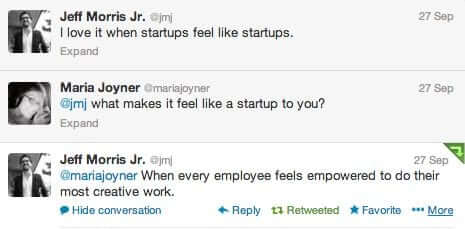Do you ever wonder how a tiny startup with just a few people can accomplish so much in a short time? Why are corporations like Coca-Cola, Home Depot, and Panasonic modeling their internal innovation teams after technology startups? Why are talented college graduates choosing a risky startup instead of the high salary corporate job?
The answers lie in startup culture.
Culture isn’t buying a keg and ping-pong table or changing the dress code to jeans and flip-flops. Culture is about creating an environment where every employee can produce his/her best work.
Focus on individuals and interactions over processes and tools. (Agile Manifesto) It starts with the team dynamics. Encourage open communication and collaboration. A problem can often be resolved fastest working together. Replace unnecessary meetings with quick conversations. Many startups employ an open floor plan that allows for rapid communication and problem solving. Welcome ideas, feedback, and suggestions from everyone on the team, regardless of their area of expertise. Conduct lunch-n-learns designed to bring different departments together.
Build a results-driven environment. Give someone a job and trust them to do it. Everyone on the team should feel empowered to produce their most creative work and be provided the tools and environment needed to succeed. Don’t micromanage. If a task takes one person 2 hours to complete and another person finds a way to complete it in 30 minutes, great! Delegate ownership of tasks and projects based on team strengths. Optimize for efficiency by getting rid of unproductive items and meetings. Meetings suck the life out of people. I’m a big fan of “No Meeting Mondays,” or reserving one day a week as a “No Meeting Day.” Celebrate successes as a team. When big deals are closed, I’ve seen startups do everything from a team high-five to hitting a gong to busting out a Top 40 hit from the 90s.
Responding to change over following a plan. This is another principle in the Agile Manifesto and a key component of the Lean Startup. Be aware of what is working well and constantly seek ways to improve the current process. For example, rather than write a traditional 50-page business plan, I recommend using the Business Model Canvas. With a heavy focus in customer discovery before launching or pivoting, it constantly helps identify the most efficient and effective plan.
A team needs to be agile enough to embrace and act upon time-sensitive opportunities that can significantly impact the bottom line. Look at Oreo’s swift response to the light outage at 2013’s Super Bowl. Within minutes, Oreo tweeted this image.
How can you apply these principles in your company? Are you empowered to do your most creative work?
Maria Joyner is a growth hacker with Synapp.io, an Atlanta technology startup focused on email deliverability and compliance. Synapp.io helps email marketers get and stay in compliance with their Email Service Providers through ongoing monitoring and email assurance. Check out her website and her blog.



